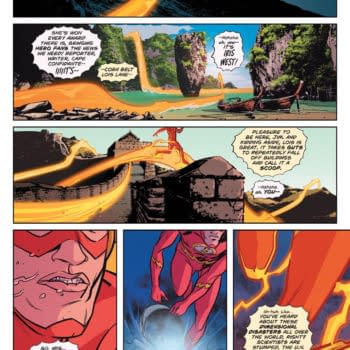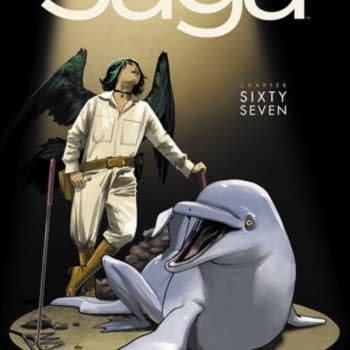Posted in: Comics, Recent Updates | Tagged: adaptations, Comics, entertainment, Galen Showman, HarperCollins, Jill Thompson, kevin nowlan, Lovern Kindzierski, neil gaiman, p craig russell, rick parker, Scott Hampton, Stephen B. Scott, The Graveyard Book Volume 1, tony harris
When An Adaptation Becomes A New World – Neil Gaiman And P. Craig Russell's Graveyard Book Volume 1
I've experienced a modicum of debate in my time over the role of adaptations into the comics medium from prose novels, film, or TV properties and even those with a great respect for the comics medium often undervalue a work that has the "adaptation" label attached, as if that may be a devaluing quality that threatens artistic integrity on the work. Even those who champion the potential of adaptations to become major works of artistic achievement always seem to add words like "some" or "a few", hinting that there are adaptations they feel are just aggrandizing on the prior public knowledge of a property or set of characters.
This may seem like an out of place preamble when discussing a book created by such established masters in the field of comics like Neil Gaiman, and the artists on this work including P. Craig Russell, Kevin Nowlan, Tony Harris, Scott Hampton, Galen Showman, Jill Thompson, and Stephen B. Scott. Even the most diehard skeptic when it comes to the strengths of adaptation into he comics medium would probably assume this work transcends those prejudices. But I make my point here precisely because this book should change readers' minds about their assumptions when it comes to adaptation, and I certainly hope that it will at least give them pause the next time they add qualifying phrases to whether or not an adapted work can be a major achievement in comics. Because only at that point will the scales tip and the qualifying phrases be used to describe the adaptations of lesser quality. It takes sterling examples to change peoples' minds and this is one of those books.
The Graveyard Book Volume 1, to be released July 29th by HarperCollins, is a new work. It is not just a version of the New York Times Best-selling The Graveyard Book by Neil Gaiman that has been handled competently in a way that does justice to the original and simply allows you to experience the story in an alternate format, though of course, it tells the story of our protagonist Nobody 'Bod' Owens and his adoption into the afterlife of a protective cemetery in a recognizable way. To some extent we, as readers, do expect a good adaptation to be faithful to the original text, and that can often reach a fever pitch if we have emotional ties to the first experience we had of a story or characters.
Very occasionally an adaptation can differ radically and still seem to win us over through its sheer ingenuity. The Graveyard Book Volume 1 is, indeed, faithful to the original prose novel. And yet it is not cautiously so. The artwork does not take a backseat to making sure that the prose is paramount. For those familiar with the work of P. Craig Russell, you'll note that he has long experience handling very dense storytelling and making choices about how to convey intricate narratives without crowding artwork with text, as in his Ring of the Nibelung Cycle. He's also a remarkable visual magician when it comes to panel arrangement and creating very full pages that really reinforce the "novel" in the phrase "graphic novel". One of the features of his artwork that enables him to do this so graceful is his careful study of expression and pose in his characters, also seen in his adaptation of Gaiman's novella Coraline.
Though it may seem strange to say, one of Russell's other major strengths is clothing. What I mean by that is that he uses the movement of fabric and costume to great atmospheric effect as far more than merely passing, necessary details. Clothing is always essential to his characters and expresses their movement, attitudes, emotions, and the general tone of the story. In The Graveyard Book, Russell has two main challenges on this front—the fact that Silas is almost entirely made up of an ever-changing sweeping cape (note the cover where he seems to have no body at all inside it) and secondly that Bod spends the majority of the book in a ragged t-shirt/nightshirt which could have very limiting potential. Both become focus points for Russell which he seems to see strengths in, from Silas' constantly shifting perceptions of the world around him depicted when his cape seems to "react" even before he does, to Bod's t-shirt which crumples, trails, coils, and flies like a canvas of his internal states. Are you getting the sense that this adaptation is a new work of art yet? Hopefully so.
Russell is responsible for the art on the second of the five chapters of Volume 1, so that leaves four other chapters of artistry to consider as well. What does it mean when you have a graphic novel that is, in some ways, an anthology project, telling one narrative, but in differing visual voices? There is actually a tendency among readers to consider an adaptation even less "serious" in this case, as if it's less likely to make a strong artistic statement. The Graveyard Book Volume 1 has the opposite effect, and perhaps the opposite reasoning behind it.
Gaiman is, of course, known as a writer for both his comics and his prose works. In both he's known for his narrative and dialogue which is very careful chosen and even feels pared down to essential, evocative words. But with "evocative" language, there is an almost limitless expanse of possible interpretations. There is never any question that the reader is expected to be highly participatory in creating the world of Gaiman's prose works. When it comes to comics, he gives artists a very wide-ranging freedom in rendering what his prose suggests to them. But why would the work of over a half-dozen artists in this case make for a better adaptation that is a new thing? Because that is actually more in keeping with the "spirit" as much as the "letter" of the text as translators say when handling languages. There is no single way to depict this story visually, and the team on the book reflects that and openly embraces it. And that declaration is a major strength of this adaptation.
Kevin Nowlan opts for a degree of realism that renders the harsh realities of violence that open the book in chilling detail, but pursues that angle further to establish the world of the book by quite literally making us believe in the reality of ghosts, so he's an uncannily apt choice for the first chapter. Russell blends his firmly delineated characters with his characteristic light touch with hinting at mythological motifs establishing the graveyard as a kind of twilit Eden that Bod moves in, reminding the reader that simply anything could happen there and that's just the basic principle of Bod's world.
Tony Harris' fluid, expressive inking tracks Bod's emotional development and responses whereas Scott Hampton's work on the third chapter faded into strange areas of uncertainty depicting "ghouls" and their realm, Galen Showman picks out the fine lines of historical narrative and Bod's first exploration of the outside world in a way that seems to suggest that the basic realities of human life do not really change over time, though epochs may change their clothes, and Jill Thompson's contributions to the final chapter of Volume 1 will challenge your perceptions of different versions of reality that Bod is experiencing, particularly with Lovern Kindzierski's choice of explosive shifts in color palette that are almost musical in their developments in keeping with the storyline as it develops to this crescendo. Stephen B. Scott's final "Interlude" that closes the book knows how to create the claustrophobic sense of a conspiratorial world in texture and setting as well.
There's another aspect to The Graveyard Book Volume 1 that should be mentioned that only ads to its artistic achievement and is an excellent water-mark for the goals of the book—it's entirely hand lettered by Rick Parker. All 188 pages of it. In many ways, his work is the subtle continuity, a visual "voice" that runs through the narrative enabling the shifts between different art styles. It's not simply nostalgia or adding a flourish to the book to insist on hand lettering, but a statement about its craftsmanship and the personal way that the narrative needs to work on the reader. The text of the story comes alive in its movement and angles in a way that's very hard to achieve, if not impossible to do so, digitally. The fact that the book is hand lettered in this way is a final statement of the artistic commitment on the book and belief in the comics medium from all contributors.
There's only one drawback to all of this virtuosity on The Graveyard Book Volume 1, and that is that it sets indelible standards for adaptations that can only be influential. In other words, less impressive adaptations will now seem even more lacking than before.
Naturally, the way that you read and experience this work will make it a different creation than the prose novel of The Graveyard Book, and any adaptation to the comics medium can make that claim, but there's quite simply a lot more going on here than suggested by such a basic differentiation. Whatever your history with the prose novel of The Graveyard Book may be, this book is a different world you have never entered before and a whole team of artists have made sure of that for you so be prepared for a new adventure—you've been warned.
On a side-note, The Graveyard Book is also coming to a "full cast audio edition" on September 30th, with Neil Gaiman, Derek Jacobi, Robert Madge, Miriam Margoles, and many more, so that will be a whole other world of adaptation and new experiences as well.
Hannah Means-Shannon is EIC at Bleeding Cool and @hannahmenzies on Twitter


















